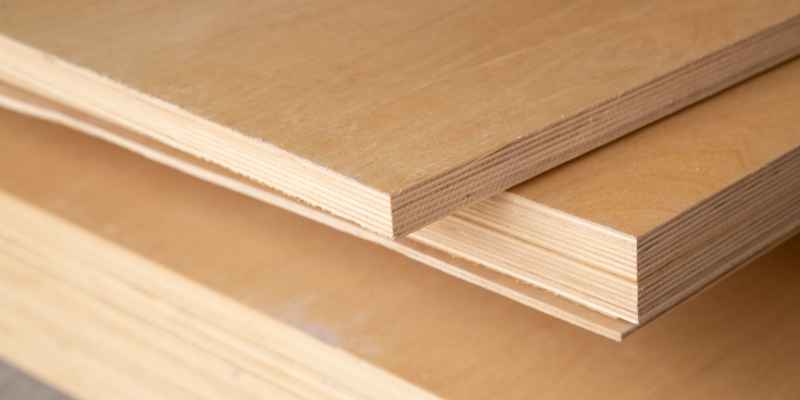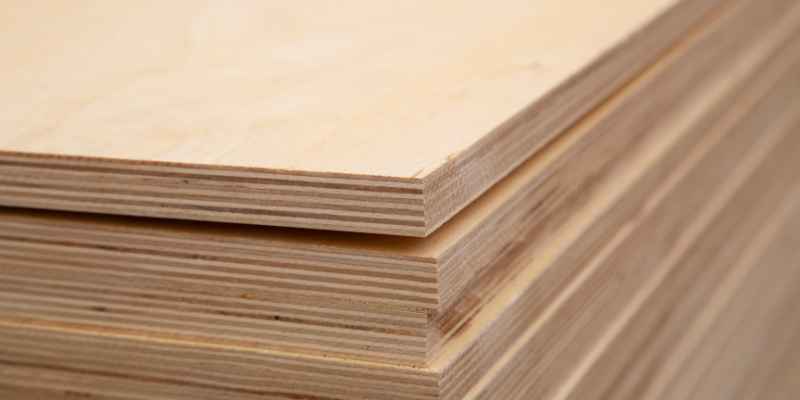To dispose of plywood, take it to a local recycling center or arrange for a waste collection service. Proper disposal helps protect the environment and keeps your space clutter-free.
If you have old plywood lying around, it’s important to find the right way to get rid of it. By following the correct disposal methods, you can ensure that the plywood is recycled or disposed of in an environmentally friendly manner.
Let’s explore some effective ways to responsibly dispose of plywood and contribute to a cleaner, greener environment.
The Importance Of Proper Plywood Disposal
Proper plywood disposal is crucial for environmental sustainability. To dispose of plywood, consider recycling it at a local facility or repurposing it for DIY projects. Avoid landfilling plywood to reduce waste and promote eco-friendly practices.
Proper disposal of plywood is crucial for several reasons. Not only does it help protect the environment, but it also ensures compliance with legal regulations. Understanding the impact of plywood waste on the environment and the legal considerations involved can guide you in making responsible choices when it comes to disposing of plywood.
Environmental Impact Of Plywood Waste
Plywood waste can have significant environmental consequences if not disposed of properly. Here are some key factors to consider:
- Pollution: Plywood often contains adhesives, coatings, or treatments that can release harmful chemicals into the environment if not handled correctly. These chemicals can contaminate soil, water sources, and the air we breathe, posing risks to both human health and ecosystems.
- Landfill Space: Improper disposal of plywood contributes to the increasing burden on landfills. Plywood takes up a significant amount of space due to its size and durability, reducing the capacity for other waste materials. This can result in the need for more landfills, which further impacts the environment.
- Deforestation: Plywood is made from wood, and the demand for plywood contributes to deforestation. Proper disposal helps reduce the need for excessive logging and promotes sustainable forestry practices.
Legal Considerations And Regulations
When disposing of plywood, it is essential to be aware of the legal considerations and regulations in your area. Here are some important points to keep in mind:
- Local Regulations: Different regions may have specific rules and guidelines for plywood disposal. Familiarize yourself with local regulations to ensure compliance and avoid potential penalties or fines.
- Hazardous Waste Classification: Depending on the chemicals or treatments present in the plywood, it may be classified as hazardous waste. Hazardous waste often requires special handling and disposal procedures to prevent harm to human health and the environment.
- Recycling Opportunities: In many cases, plywood can be recycled or repurposed instead of being thrown away. Research local recycling facilities or organizations that accept plywood for recycling to minimize waste and promote sustainability.
By understanding the environmental impact of plywood waste and adhering to legal considerations and regulations, you can play a vital role in promoting responsible plywood disposal. Remember, your actions contribute to a cleaner and healthier environment for current and future generations.
Types Of Plywood And Disposal Challenges
Plywood is a versatile and widely used building material, but disposing of it can be challenging due to its various types and treatment methods. Understanding the different grades of plywood and the disposal challenges associated with them is essential for proper waste management. Let’s explore the types of plywood and the disposal challenges they present.
Identifying Different Plywood Grades
When disposing of plywood, it’s crucial to first identify its grade, which indicates its quality and potential for reusability. The most common grades include A, B, C, and D, with A being the highest quality and D being the lowest. Higher-grade plywood is often used in furniture and cabinetry, while lower grades are suitable for structural applications.
Challenges With Treated And Untreated Plywood
Treated plywood, such as pressure-treated or marine-grade plywood, poses environmental challenges due to the presence of chemicals like preservatives and adhesives. Disposing of treated plywood requires adherence to specific regulations to prevent soil and water contamination. On the other hand, untreated plywood may be recyclable, but it still presents challenges in terms of finding appropriate recycling facilities and managing its bulk.
Pre-disposal Preparation
When disposing of plywood, proper preparation is essential to ensure safe and efficient disposal. This involves cleaning and dismantling the plywood, as well as sorting it by type and condition. By following these steps, you can ensure that the plywood is ready for environmentally responsible disposal.
Cleaning And Dismantling Plywood
Before disposing of plywood, it’s important to clean it to remove any dirt, debris, or adhesives. Use a soft brush or cloth to gently remove any surface dirt and dust. Additionally, dismantle any hardware or attachments from the plywood, such as nails, screws, or metal brackets. This will make the plywood easier to handle and dispose of safely.
Sorting Plywood By Type And Condition
Once the plywood is cleaned and dismantled, sort it based on its type and condition. Separate plywood sheets from composite wood products, such as particleboard or MDF. Additionally, categorize the plywood based on its condition, separating reusable or recyclable pieces from those that are damaged or unsalvageable. This sorting process will facilitate proper disposal and recycling, minimizing environmental impact.
Recycling Options For Plywood

When it’s time to dispose of plywood, consider recycling options. Many recycling centers accept plywood for processing into new products, reducing waste and environmental impact. Check with local facilities to find the best way to recycle plywood responsibly.
If you have old or unused plywood that you need to dispose of, recycling is a great environmentally-friendly option. Recycling not only reduces waste sent to landfills, but it also helps conserve resources by repurposing materials. In this section, we will explore two main recycling options for plywood: local recycling programs and specialized plywood recycling facilities.
Local Recycling Programs
Many cities and municipalities offer local recycling programs that accept plywood and other wood materials. These programs are typically run by waste management agencies or local recycling centers. To find out if your area has a local recycling program for plywood, you can check the website of your city or town, or contact your local waste management agency.
When recycling plywood through a local program, it’s important to prepare the material properly. Here are some guidelines to follow:
- Remove any nails, screws, or other metal fasteners from the plywood.
- Separate the plywood from other wood materials, such as particleboard or MDF.
- Check if there are any size or thickness restrictions for the plywood accepted by the program.
- Ensure the plywood is clean and free from any contaminants, such as paint or glue.
Following these guidelines will help ensure that your plywood is accepted and can be properly recycled through the local program.
Specialized Plywood Recycling Facilities
In addition to local recycling programs, there are also specialized plywood recycling facilities that focus specifically on wood recycling. These facilities have the expertise and equipment to handle large quantities of plywood and process it into new usable products.
If you have a significant amount of plywood to recycle, you may want to consider reaching out to specialized plywood recycling facilities in your area. These facilities often accept plywood from construction sites, manufacturing companies, and other large-scale sources. They may also offer pick-up services or drop-off locations for convenience.
When contacting a specialized plywood recycling facility, it’s recommended to inquire about their specific requirements and procedures for accepting plywood. This will help ensure a smooth recycling process and maximize the chances of your plywood being properly recycled.
In conclusion, recycling plywood is a sustainable and responsible way to dispose of this versatile material. By exploring local recycling programs and specialized plywood recycling facilities, you can contribute to the conservation of resources and the reduction of waste in your community. Take the necessary steps to prepare your plywood for recycling and reach out to the appropriate recycling facilities to make a positive impact on the environment.
Repurposing And Upcycling Ideas
When it comes to disposing of plywood, repurposing and upcycling are eco-friendly and creative ways to give new life to this versatile material. Instead of throwing away old or unused plywood, consider transforming it into something useful or decorative. Here are some repurposing and upcycling ideas to inspire you:
DIY Projects And Home Decor
Embrace your creativity and get hands-on with these DIY projects and home decor ideas using old plywood:
- Create rustic wooden shelves for displaying plants or books.
- Construct a stylish coffee table or side table with reclaimed plywood.
- Design and build unique wall art or picture frames using plywood scraps.
Community Projects And Donations
Consider contributing to your community by repurposing plywood for various projects or donating it to those in need:
- Collaborate with local schools or community centers to provide plywood for art classes or construction projects.
- Donate plywood to nonprofit organizations or charities that support housing and shelter initiatives.
- Participate in community clean-up efforts by repurposing plywood for building and repairing public infrastructure.
Eco-friendly Disposal Methods
When it’s time to dispose of plywood, opting for eco-friendly methods is crucial. Here are some sustainable ways to dispose of plywood without harming the environment:
Composting And Biodegradation
Composting plywood scraps can help them naturally break down and enrich the soil.
Biodegradation allows plywood to decompose over time without leaving harmful residues.
Professional Eco-friendly Disposal Services
Professional services can ensure proper disposal of plywood using eco-friendly methods.
Experts handle the recycling or repurposing of plywood to reduce environmental impact.
Avoiding Landfills: Why It Matters
Disposing of plywood properly is crucial to reduce environmental impact. Let’s explore why avoiding landfills is essential.
The Effects Of Plywood In Landfills
Plywood in landfills releases harmful chemicals into the soil and water.
Alternatives To Landfill Disposal
Recycling plywood reduces waste and supports sustainability efforts.
Tips For Reducing Plywood Waste
When disposing of plywood, it’s important to consider ways to minimize waste. Follow these tips to reduce plywood waste effectively:
Choosing Sustainable Plywood Alternatives
- Opt for FSC-certified plywood to ensure sustainable sourcing.
- Consider bamboo or composite wood as eco-friendly options.
- Choose reclaimed plywood for a more environmentally conscious choice.
Implementing Plywood Waste Reduction In Projects
- Plan projects carefully to minimize excess plywood usage.
- Optimize cutting to reduce leftover scraps.
- Reuse plywood offcuts for smaller projects or repairs.
- Donate unused plywood to community centers or schools.

Frequently Asked Questions
How Do I Dispose Of Plywood?
Plywood can be disposed of by taking it to a local recycling center or landfill. Some areas may offer curbside pickup for large items. It’s important to check with your local waste management agency for specific guidelines and restrictions.
Can I Burn Plywood?
No, burning plywood is not recommended as it can release toxic fumes into the air. Additionally, burning plywood may be illegal in some areas due to air pollution regulations.
Is Plywood Recyclable?
Yes, plywood is recyclable. It’s important to check with your local recycling center for specific guidelines on how to properly recycle plywood.
Can I Reuse Plywood?
Yes, plywood can be reused for various DIY projects such as building shelves, tables, and even furniture. It’s important to inspect the plywood for any damage or wear before reusing it.
Conclusion
Properly disposing of plywood is essential for both the environment and personal safety. From recycling to repurposing, there are various methods to choose from. Remember to check with your local waste management authority for specific guidelines and regulations. By taking the necessary steps to dispose of plywood responsibly, we can all do our part in creating a cleaner and safer world.


